Near-infrared therapy's effectiveness depends on using precise power settings to achieve the best therapeutic benefits. You'll need to maintain power density between 10-200 mW/cm² for the light energy to properly penetrate and stimulate your target tissues. The exact setting depends on your treatment goals – lower densities work for surface issues while deeper tissues require higher power levels up to 200 mW/cm². Treatment duration, wavelength selection, and proper safety protocols also play essential roles in your results. Understanding these power parameters will help you maximize your therapy's healing potential and avoid potential risks.
Understanding Power Density Fundamentals
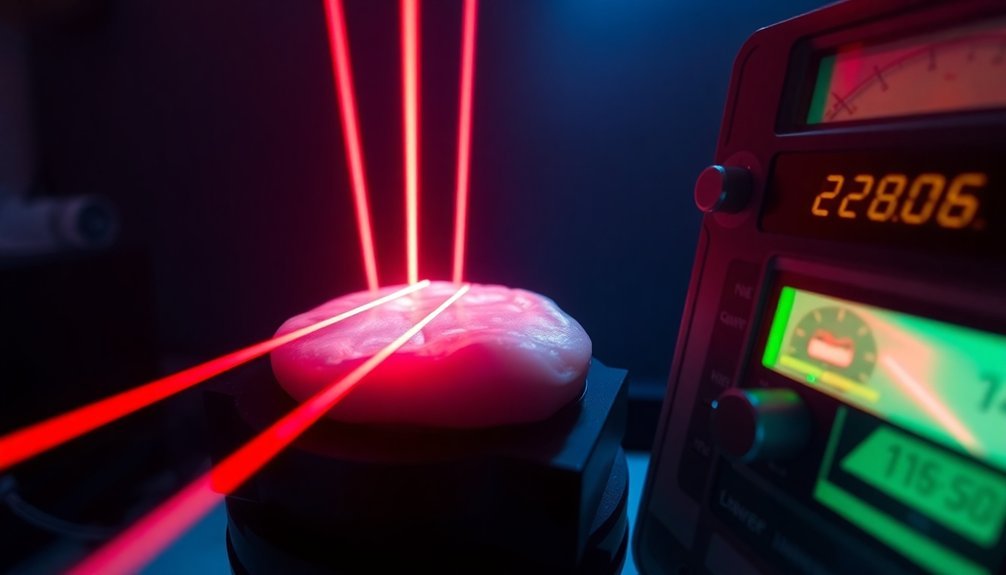
In the field of near-infrared therapy, power density serves as a critical measurement that determines treatment effectiveness. When you're using near-infrared devices, you'll need to understand that power density measures the amount of light power per unit area, typically expressed in watts per square meter (W/m²) or milliwatts per square centimeter (mW/cm²). This measurement directly impacts how much therapeutic energy reaches your target tissue. Cellular mitochondria activation occurs when the precise power settings are achieved.
You'll find that power density changes based on your distance from the light source, with the intensity decreasing as you move farther away. For accurate measurements, you'll need to use a calibrated optical power sensor or radiometer set to the specific wavelength of your device.
LED and laser devices provide the most precise readings, while full-spectrum lights can lead to less accurate measurements.
When you're planning treatments, keep in mind that therapeutic ranges typically fall between 10 and 200 mW/cm². While higher power densities can penetrate deeper tissues, they also require shorter treatment times and careful monitoring to avoid adverse effects.
You'll need to balance these factors to achieve ideal results while maintaining safety during your near-infrared therapy sessions.
Optimal Treatment Parameters
Success in near-infrared therapy relies heavily on selecting the right treatment parameters for your specific needs. You'll need to take into account several key factors to achieve the best results, including wavelength selection, power density, and treatment duration.
For near-infrared treatments, you'll want to use wavelengths between 800-850nm, with 830nm being particularly effective for deep tissue penetration. Medium intensity light requires sessions of 5-10 minutes for optimal therapeutic benefits.
Your device's power density should fall between 40-100 mW/cm² for most applications, though you can use up to 200 mW/cm² for shorter durations when targeting deeper tissues.
Your treatment dose should typically range from 3-50 J/cm², but you'll need to be careful not to exceed 6 J/cm² when treating cellular issues, as higher doses may negate benefits. Calculate your dose by multiplying power density by treatment time. You'll find that higher intensity treatments require shorter sessions, while lower intensities need longer exposure.
For the best results, you should schedule treatments between 2-14 times per week, depending on your condition.
Remember that the distance between the light source and your treatment area greatly impacts the intensity, so maintain consistent positioning throughout your sessions.
Light Penetration Depth Factors
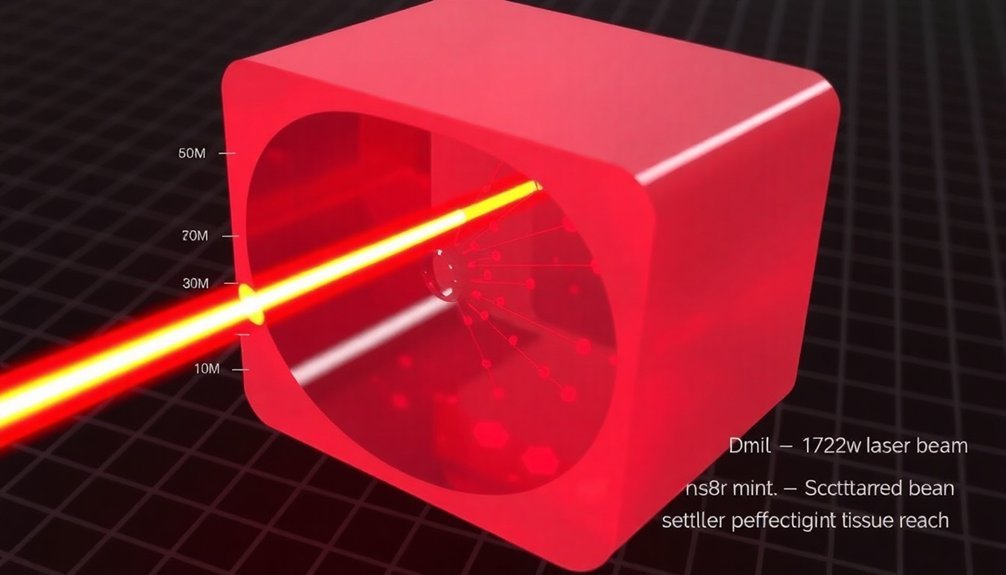
While setting ideal treatment parameters lays the foundation for effective therapy, understanding light penetration factors helps you maximize those settings. Different wavelengths penetrate tissue at varying depths, with near-infrared light (780-980nm) reaching deeper than red light (600-700nm). You'll achieve the best penetration around 810nm, as this wavelength experiences minimal absorption by skin components. Studies show systemic healing effects can occur even in areas not directly exposed to the light.
The optical window between 600-900nm offers your best opportunity for deeper tissue penetration, as melanin, hemoglobin, and water absorb less light in this range.
You'll need to take into account that even with higher intensity settings, you'll lose significant power as light travels deeper into tissue. While increased surface intensity can improve penetration, only trace amounts may reach deeper tissues.
To maximize penetration depth, you'll want to guarantee direct skin contact during application, as non-contact methods can result in up to 60% light loss through reflection and refraction. When you're targeting deeper tissues, think about using higher-powered continuous wave settings or pulsed applications with increased peak power.
Remember that red light typically penetrates up to 1mm, while NIR can reach approximately 2mm or more.
Safety Considerations During Application
You'll need to monitor heat exposure carefully when using near-infrared therapy, ensuring sessions don't exceed manufacturer-specified time limits and checking your skin regularly for signs of excessive warmth.
Always wear the recommended protective eyewear to shield your retinas from potential damage during treatment sessions.
If you're using a high-powered device, maintain proper distance between the device and your skin to prevent overheating and potential burns.
Heat Exposure Guidelines
Understanding proper heat exposure guidelines is critical when using near-infrared therapy, as excessive thermal exposure can lead to serious health risks.
When you're using near-infrared therapy, you'll need to monitor your exposure time carefully, as thermal burns can occur at temperatures of 45°C or higher, especially during shorter exposure periods. Don't exceed 10 seconds of exposure without carefully monitoring your skin's response.
You should watch for signs of prolonged erythema (skin redness) and stop treatment immediately if it occurs.
If you have impaired cutaneous thermal sensations or you're sensitive to heat, you shouldn't use infrared therapy. It's crucial to maintain your body's thermal balance and stay hydrated throughout the treatment.
You'll need to be particularly cautious if you have any metal implants, cardiovascular conditions, or skin conditions like dermatitis or eczema.
Don't use infrared therapy while under the influence of alcohol or certain medications, as these can affect your body's ability to regulate temperature.
If you have specific health concerns, make sure you're using the therapy under medical supervision and following the manufacturer's guidelines precisely.
Protective Equipment Requirements
Building on proper heat exposure practices, protective equipment serves as your primary defense during near-infrared therapy sessions. When you're within the beam window, protective eyewear becomes essential, especially during treatments involving near-infrared radiation.
You'll need specialized FDA-approved glasses that block both red and near-infrared light, guaranteeing maximum protection against potential eye damage.
The quality of your protective equipment matters considerably. Choose eyewear that blocks up to 99% of near-infrared light and maintains a secure fit throughout your treatment sessions. When you're treating areas near your face, don't rely on closed eyes alone – proper protective goggles are vital for your safety.
- Look for blackout goggles with certified polycarbonate lenses
- Make certain your protective eyewear fits securely without light leakage
- Keep others, including children and pets, away from the direct beam window
- Wear protection even during brief exposures within the treatment distance
- Replace damaged or worn protective equipment immediately
Remember that while red light therapy without NIR mightn't always require protective eyewear, it's better to err on the side of caution and consult your healthcare provider about specific protection requirements for your treatment protocol.
Tissue Response To Power Settings
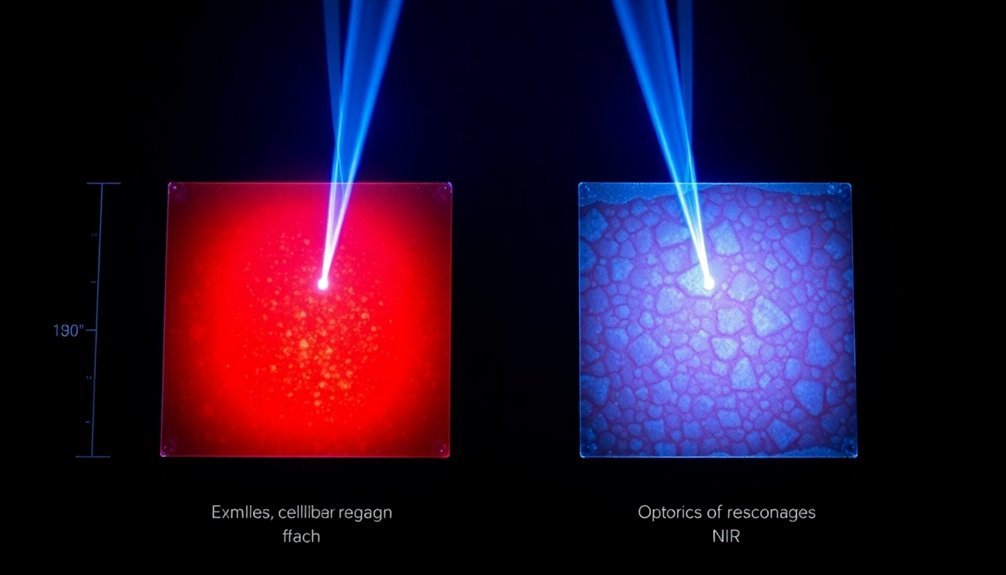
When you're using near-infrared therapy, you'll notice different tissue responses based on your power settings – surface tissues respond quickly to lower settings while deeper tissues require higher power for effective penetration.
Your treatment time needs adjustment based on these power variations, with longer sessions typically needed for deeper tissue targets.
Higher power settings will produce more heat in the targeted area, so you'll need to monitor tissue temperature and adjust accordingly to prevent overheating while maintaining therapeutic effectiveness.
Surface Vs Deep Penetration
The relationship between power intensity and tissue penetration depth presents a vital dynamic in near-infrared therapy. You'll need substantially higher power settings to reach deeper tissues, as more than 90% of NIR light energy gets absorbed within the first 10mm.
When you're targeting surface-level treatments, red wavelengths (600-700nm) penetrating up to 1mm might suffice, but deeper tissues require near-infrared wavelengths (700-900nm) that can reach up to 2.5mm.
For effective deep tissue treatment, you'll want to take into account these essential factors:
- Continuous Wave (CW) delivery provides better depth penetration than Pulsed Wave for deeper treatments
- Direct skin contact maximizes penetration by reducing light reflection and refraction
- Wavelengths between 650-1360nm offer the best therapeutic window for maximum tissue penetration
- Higher wavelengths (850-900nm) penetrate deeper than lower ones (633-660nm)
- Treatment of deep tissues requires considerably higher power intensity, often 100mW/cm^2 or more
When targeting deeper structures like muscles, joints, or brain tissue, you'll need to compensate for the noteworthy power loss that occurs as light travels through various tissue layers. This makes power intensity selection particularly vital for achieving therapeutic effects at your target depth.
Response Time Parameters
Tissue response time patterns during near-infrared therapy depend heavily on power density thresholds and cellular metabolic mechanisms. You'll need at least 10 mW/cm² for effective treatment, though higher densities typically trigger better metabolic responses in your tissues.
Your body's response to NIR light involves several biological mechanisms. The light interacts with your tissues to release nitric oxide from hemoglobin and myoglobin, while Cytochrome C Oxidase mediates reactions that increase blood flow. Your cells' mitochondria activate locally when exposed to pulsed NIR light, enhancing their metabolic function.
You'll see different response times based on treatment location, as tissue types vary in their NIR light penetration. The ideal wavelength range of 800-830 nm works best, but you'll notice reduced effectiveness below 700 nm due to hemoglobin absorption or above 950 nm from water absorption.
Your treatment duration matters substantially. Short-term exposure with high power density often works better than longer sessions with low power density. You'll achieve ideal results by carefully controlling total fluence while adjusting both power density and exposure time to match your specific treatment needs.
Power-Related Heat Effects
During near-infrared therapy sessions, power-related heat effects vary substantially based on wavelength and intensity settings. When you're using red light, you'll notice skin warming at around 30-40mW/cm², while near-infrared wavelengths can operate at higher intensities without excessive heating due to their deeper penetration.
This difference occurs because NIR spreads energy over larger tissue volumes, reducing surface temperature increases.
Device design plays a vital role in managing heat effects. You'll need to be particularly cautious with LED devices wrapped tightly against your skin, as these can quickly build up heat at intensities above 50mW/cm².
The size of the treatment area also impacts thermal accumulation – larger areas require more careful monitoring of temperature effects.
- Keep intensity below 50mW/cm² for extended treatments to avoid excessive heating
- Monitor skin temperature during sessions, especially with red light wavelengths
- Allow proper spacing between LEDs to minimize contact heating effects
- Use pulsed settings when working with higher power intensities
- Choose NIR wavelengths (800-850nm) when higher power settings are needed for deeper penetration
Always remember that exceeding 43°C can trigger heat pain, so adjust your settings accordingly to maintain comfortable and safe treatment conditions.
Wavelength Selection For Results
Selecting appropriate wavelengths stands as a critical factor in achieving ideal therapeutic results with near-infrared therapy. You'll need to understand that different wavelengths serve distinct purposes, with the therapeutic window ranging from 650-1200 nm offering the best tissue penetration without generating excessive heat.
For surface-level treatments, you'll want to focus on red light wavelengths around 660 nm, which effectively increase blood flow and reduce surface inflammation.
When you're targeting deeper tissues, opt for near-infrared wavelengths between 800-900 nm, as these penetrate further into your body and trigger increased cell metabolism.
You'll find that specific wavelengths like 850 nm excel at deep tissue penetration, while 880 nm shows promise in wound healing applications. If you're dealing with more complex conditions, wavelengths like 940 nm are being researched for specialized treatments, including COVID-19 outcomes.
Remember that your tissue type matters – different tissues respond better to specific wavelengths. You'll get the best results by matching the wavelength to your therapeutic goals, whether that's stimulating mitochondrial activity, promoting cell regeneration, or reducing inflammation in deeper tissues.
Treatment Duration Guidelines
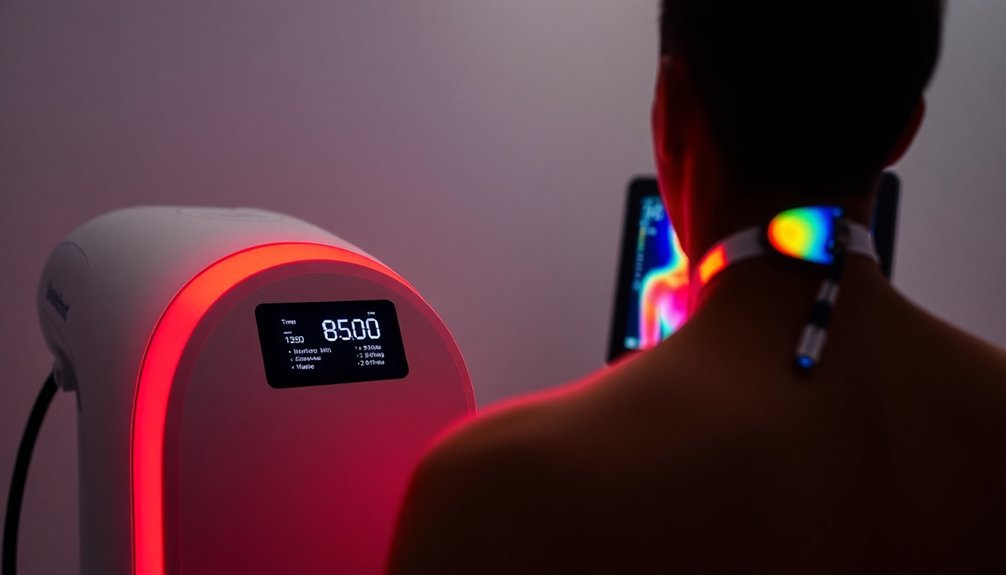
Timing plays a crucial role in maximizing the benefits of near-infrared therapy. Your treatment sessions can range from a few minutes to 20 minutes, depending on your device's power settings and the specific area you're treating.
When using higher-wattage devices, you'll need shorter treatment durations, while lower-power units may require extended exposure times to achieve the best results.
You'll want to follow your device manufacturer's guidelines precisely, as they've designed specific programs based on extensive testing. If you're using infrared lamps, remember to warm them up for about 15 minutes before treatment to guarantee maximum emission strength.
For consistent results, you should maintain regular treatment sessions, whether daily or several times per week. As you progress, you can adjust to maintenance sessions based on your body's response and treatment goals.
- Keep your skin clean and bare during treatments
- Position your device at the recommended distance and angle
- Start with shorter durations if you're new to near-infrared therapy
- Use protective eyewear during every session
- Monitor your skin's response and adjust treatment time accordingly
Frequently Asked Questions
Can Near-Infrared Therapy Help With Seasonal Affective Disorder (Sad)?
Yes, you can use near-infrared therapy to help manage SAD symptoms. It'll penetrate deeply into your brain tissue, boost neurotransmitters, and improve your mood. It's especially effective when combined with traditional light therapy.
How Does Medication Interact With Near-Infrared Therapy Treatments?
You'll need to check your medications carefully, as some can cause photosensitivity reactions. Stop certain drugs 1-5 days before treatment, and always consult your healthcare provider about potential medication interactions.
Is Near-Infrared Therapy Effective Through Clothing or Bandages?
You'll get some benefits through thin, light-colored clothing and bandages, but they'll reduce the therapy's effectiveness. For the best results, you should expose your skin directly to the near-infrared light when possible.
Does Skin Pigmentation Affect the Required Power Settings?
Yes, your skin pigmentation substantially affects power settings needed. If you have darker skin with more melanin, you'll need higher power settings to achieve the same penetration depth as lighter skin types.
Can Near-Infrared Therapy Be Combined With Other Light Therapies?
Yes, you can safely combine near-infrared therapy with other light treatments like red light therapy. You'll get enhanced benefits since different wavelengths target various tissue depths and conditions simultaneously. Just follow proper safety guidelines.
In Summary
You'll need to carefully monitor and adjust your near-infrared therapy power settings to achieve ideal results. Remember you're working with specific power densities between 10-200 mW/cm², which directly impact tissue penetration and treatment effectiveness. When you're setting up your therapy sessions, don't forget to match the power settings to your treatment goals while staying within safety parameters for your specific application.

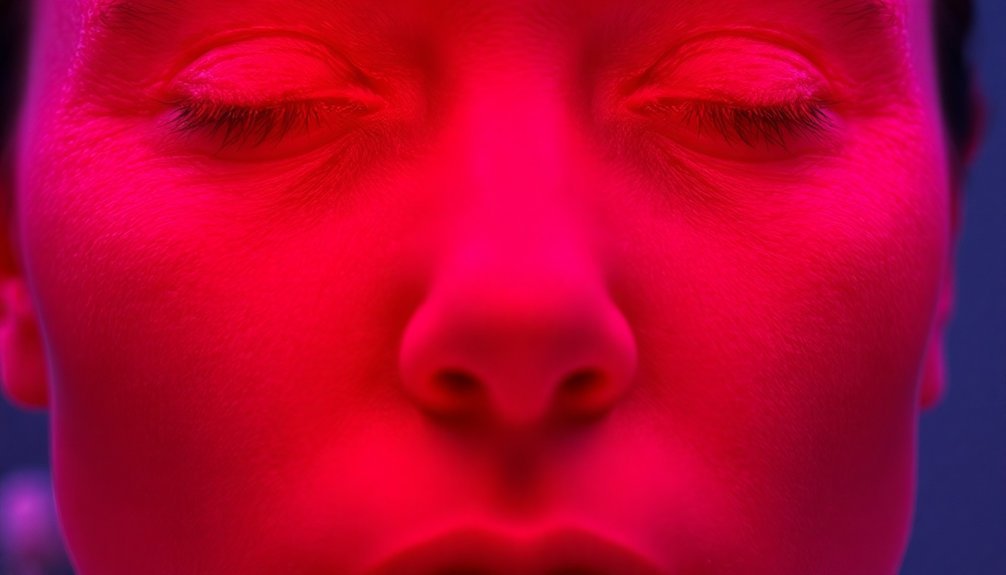



Leave a Reply